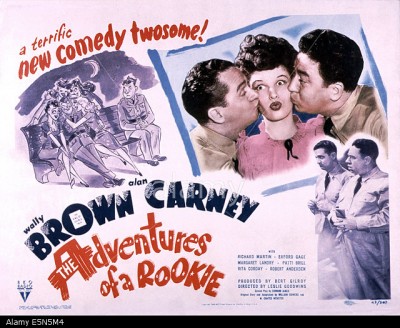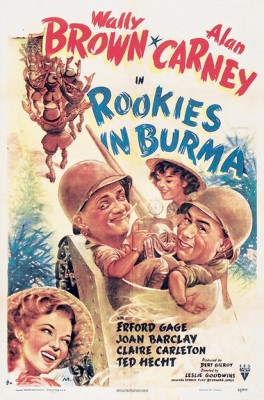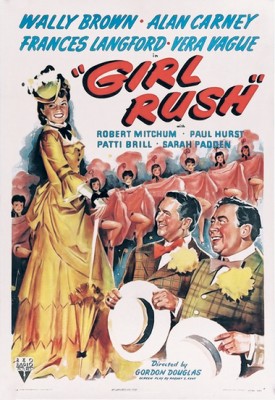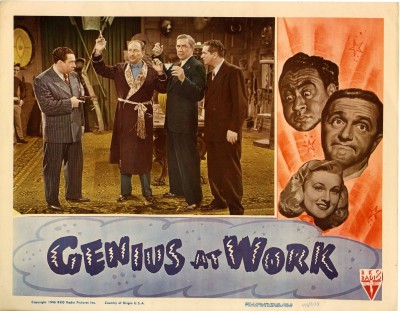| Reviews & Columns |
|
Reviews DVD TV on DVD Blu-ray 4K UHD International DVDs In Theaters Reviews by Studio Video Games Features Collector Series DVDs Easter Egg Database Interviews DVD Talk Radio Feature Articles Columns Anime Talk DVD Savant Horror DVDs The M.O.D. Squad Art House HD Talk Silent DVD
|
DVD Talk Forum |
|
|
| Resources |
|
DVD Price Search Customer Service #'s RCE Info Links |
|
Columns
|
|
|
RKO Brown & Carney Comedy Collection (The Adventures of a Rookie / Rookies in Burma / Girl Rush / Genius at Work), The
Abbott & Costello were Hollywood's hottest stars of the early 1940s, but chubby, child-like Lou Costello was unable to work for about a year beginning in March 1943 (first due to rheumatic fever and, subsequently, following the tragic accidental death of his infant son), so to fill the void RKO paired Brown and Carney for a series of Abbott & Costello-type vehicles.
Today these movies are all but forgotten, and with good reason. Note the DVD's cover art: Do these faces suggest masters of unbridled mirth? In their defense, the movies aren't all that dire. For one thing these B-movies are fairly well produced otherwise, and as movies they play better than, say, Monogram's concurrent, East Side Kids series with Leo Gorcey and Huntz Hall. Those Poverty Row comedies, at least the better ones, while marginally funnier than the sometimes laugh-less Brown & Carney vehicles, are also far cruder and more incompetent in other respects. That's not a ringing endorsement.
Though invariably dismissed as Abbott & Costello clones, in fact Brown & Carney's screen personality bore little resemblance to Universal's top stars. Abbott & Costello's act was built around several dozen burlesque sketches (most famously "Who's on First?"), classic bits tailored by writer John Grant for their distinctive personalities and modern, brassier style. Abbott was the straight man, usually a two-bit con artist forever trying to cheat Costello out of his pocket money. Costello was child-like but (up to this point) also streetwise; occasionally he'd beat Abbott at his own game.
Brown & Carney have none of these traits and, indeed, almost no personality at all. Brown's is pretty much limited to being marginally less dense than Carney, while Carney's is that he's marginally more stupid than Brown. Wally Brown is comparatively thin and saucer-eyed while Carney is fat and dopey-looking. Dumb and Dumber, they.
In their movies as a team they always played the same characters, as if it mattered: Brown played Jerry Miles while Carney was Mike Strager. Instead of trying to flesh out these fellows and draw humor from their personalities, or incorporate material from classic burlesque and Vaudeville routines as Abbott & Costello (through John Grant) had done, the scripts mostly rely on standard comedy team shtick and lame jokes.
Except for the first half of their initial outing, The Adventures of a Rookie (1943) their movies resemble Abbott & Costello's earlier hits only superficially. Brown & Carney take the same route through similar comedy sub-genres, movie types all solo comedians and comedy teams were doing around this time. For instance, Abbott & Costello's "drill routine" from Buck Privates (1940) may be the Gold Standard of such bits, but the Three Stooges did one quite similar months before in their short Boobs in Arms (1940). The Adventures of a Rookie brazenly recreates some elements from Buck Privates in its first half, but then moves off in an entirely different direction. None of the Brown & Carney films comes close to approaching the blatant thievery of a handful of other movies, notably Great Guns (1941), Fox's unacknowledged remake of Buck Privates, and a painful squandering of the talents of Laurel & Hardy.
(Reader Sergei Hasenecz adds, "You might want to mention that the team did other movies not included in this package: Seven Days Ashore, where they did not play as Miles and Strager, and Zombies on Broadway)."
In The Adventures of a Rookie, three strangers are drafted into the Army: nightclub MC Jerry Miles (Wally Brown), wealthy Bob Prescott (Richard Martin), and truck driver Mike Strager (Alan Carney). In scenes imitative of Buck Privates they and others toil through a series of medical checkups and aptitude tests before entering basic training. In a pretty funny set piece, Mike asks Jerry about one of the exam questions, concerning two drivers heading for Chicago, "A" and "B." Mike finds this hopelessly confusing, and there's some genuinely funny wordplay as Jerry tries to explain things to the terminally stupid trucker.
Bob's uncle, Commanding Officer, Col. Wilson (John Hamilton, Adventures of Superman's Perry White) informs him that he did well enough on his aptitude test to qualify for officer's training school, but also warns him that his continued association with dumbbells Mike and Jerry is potentially toxic. Bob meets-cute Peggy Linden (Margaret Landry) and later she invites him and the boys over to dinner while they're on a six-hour pass. However, Peggy's cook is diagnosed with Scarlet Fever and everyone at the party is quarantined for two weeks.
They also run afoul of grouchy Sgt. Burke (Erford Gage), Rookie's equivalent of Buck Private's Nat Pendleton. He becomes trapped in the house, too, and later Jerry, Mike, and Bob, on maneuvers, accidentally end up hundreds of miles away in San Francisco.
As the team's starring debut, The Adventure of a Rookie isn't half-bad. Wally Brown gets to sing a bit in the opening scene, and his reaction to receiving a draft notice is pretty amusing. In Vaudeville Carney apparently specialized in celebrity impersonations, and here there's a scene where he does decent though hardly uncanny imitations of Edward G. Robinson and Charles Laughton.
The movie is different enough from Buck Privates not to appear a total rip-off, especially when it veers off in its own, original direction.
The War Department, which reviewed all movie scripts a this time, didn't think much of Rookie but the film turned a modest profit and prompted a sequel, Rookies in Burma.
Rookies in Burma is an interesting programmer for all the wrong reasons. It puts the team in stock wartime comedy situations that, while mildly amusing, are the kinds of things screenwriter Edward James could've thought of in his sleep. An amusing prologue introduces the wonders of Burma (Myanmar) via stock footage, ending with a picturesque ancient pyramid, revealed as a colossal mound of potatoes Jerry and Mike are attempting to peel.
They along with nemesis Sgt. Burke (Erford Gage again) are soon captured by the Japanese (one of the Asian extras seems to be sleeping) and thrown into a POW camp. "At least we don't have to worry about peeling potatoes," says Mike, apparently unfamiliar with the Bataan Death March. The three eventually escape from their captors, with Sgt. Burke stealing a briefcase crammed with top-secret documents.
They make their way to a nightclub where they encounter fellow American entertainers Connie (Joan Barclay) and Janie (Claire Carleton), stranded since fleeing Japanese-occupied Shanghai. All make their escape aboard an Indian elephant and later, with the boys disguised as "Jap" soldiers, procure an enemy tank, hoping to use it to get back across enemy lines.
Rookies in Burma is almost fascinating considering Erford Gage had enlisted into the real Army, only to be killed during the liberation of the Philippines in 1945. (The excitable sergeant in Boobs in Arms, Richard Fiske, likewise died on the battlefield.) His death so soon after (he wears an extreme buzz cut, as if on leave from active duty) contrasts the complete unreality of war as depicted in the movie, far beyond the usual wartime comedy. In the film, Brown and Carney run around like Hope and Crosby in a Road movie, at one point disguising themselves in "native" clothes and becoming unwilling participants in a knife-throwing act.
Racial insensitivity and cultural inaccuracies abound, commonplace in post-Pearl Harbor wartime films. The Japanese are endlessly referred to as "dumb monkeys" and throughout much of the picture Brown and Carney disguise themselves as Japanese soldiers by donning huge buck-teeth and squinting their eyes. At one point they briefly switch disguises, into what might be described as Burmese blackface, exchanging the fake teeth for enormously inflated white lips. Though hardly uncommon in '40s Hollywood films, the sets and costumes aren't remotely credible: the nightclub, its customers, etc. don't look Burmese so much as Middle Eastern, while the enemy soldiers (played by non-Japanese Asians and Caucasian actors in eye makeup) all speak atrociously bad Japanese (the latter more a personal observation than a complaint).
Comedy-wise, the standard material is broken up by a few genuine routines. The first is a wordplay bit confusing "cinch" (the band for saddling the elephant) and "cinch" (easy), etc., and later Brown does a funny, halting monologue about being on a cruise. The last noteworthy bit apparently was the only time Brown and Carney ever stole material, albeit indirectly, from Abbott & Costello. They do a variation of the Mustard Sketch, in which Abbott turns Costello's dislike mustard into a national crisis. Here, the material is adapted, somewhat awkwardly, into Brown condemning Carney for refusing to sneeze, but the routine's origins are the same.
Girl Rush (1944) is a period comedy-Western, opening in 1887 San Francisco (not 1807, as stated over at Turner Classic Movies' database), where Jerry Miles and Mike Strager (or maybe their grandparents?) are comedians in a music hall revue. Word of a gold strike empties the hall and the dearth of customers force Mike, Jerry, and the showgirls, led by Flo Daniels (Frances Langford) and lovesick Suzie Banks (Vera Vague, known later as Barbara Jo Allen) to look for work elsewhere.
Jerry and Mike try their luck prospecting, winding up in the town of Red Creek, where grandmotherly hotel owner Emma (Sarah Padden) is the only woman in town. She along with stalwart miner Jimmy Smith (Robert Mitchum, on the cusp of stardom) and pal Muley (Paul Hurst), learning of the showgirls back at the dance hall, offer Jerry and Mike a sack of gold to bring the girls to town as prospective brides. However, corrupt saloon owner "Honest" Greg Barlan (Cy Kendall), fearing the women will prove a distraction that will hurt his business, plots to steal the gold and prevent the girls' arrival.
The movie's period dance hall setting anticipates Abbott & Costello's later The Naughty Nineties, released the following year, while the Western comedy apes A&C's earlier Ride ‘Em Cowboy (1942). Regardless, it's all standard, by-the-numbers comedy material with very little of interest. Mitchum, more at home playing henchman in Hopalong Cassidy films and the like at this point, looks uncomfortable playing the generic hero in this, his RKO debut, though he looks amused during a brief sequence when he, Mike, Jerry, and the other miners disguise themselves as women hoping to fool Barlan's men. Being deprived of women for so long, they are easily deceived. Yawn.
Of the four features in this set, Genius at Work (1946) is the weakest yet has the biggest drawing power, as it features horror movie stars Béla Lugosi and Lionel Atwill. Unlike Brown & Carney, there has long been a cult following for Lugosi, one that has never abated. Many will want to see this just for him.
Here Mike and Jerry are stars of the popular radio series Crime of the Week where, mainly due to the help of criminologist Latimer Marsh (Atwill), their dramatizations about a master criminal known as "The Cobra" prove uncannily accurate. Of course, that's because Marsh is the Cobra, blithely unconcerned that he's leading dimwits Mike and Jerry, along with show writer Ellen Brent (Anne Jeffries) straight to him. Lugosi plays Atwill's butler-lieutenant, who questions his boss's brazen stupidity. (On shelves in the background of Marsh's workroom, viewers can glimpse a stop-motion model Triceratops built for King Kong and a cave bear armature used in The Son of Kong.)
The movie is a remake of The Nitwits (1935), one of Wheeler & Woolsey's better comedies, which in turn influenced Abbott & Costello's similar Who Done It? (1942), one of their best films, which in turn influenced this, which isn't one-third as good as either of those. Interestingly though, in Genius at Work there's a nightclub scene featuring a dancer wearing cobra-like, elbow-length gloves. The choreography of the number has her gesturing her arms like a snake, which in turn scares Jerry. Virtually the same bit, though done better, turns up in Abbott & Costello Meet the Mummy (1955), so while Brown & Carney may have been riding Abbott & Costello's coattails, it's clear that at least one of that team's writers was likewise keeping an eye on Brown & Carney, too.
Fans of Lugosi and Atwill consider them "wasted" in Genius at Work, but that's not really true. By the 1940s, Lugosi's film work was divided between demeaningly small roles in Universal horror movies (like the 1941 Black Cat and Night Monster) or starring roles in fruity, threadbare Poverty Row films like Devil Bat and Return of the Ape Man. Genius at Work may not be a high water mark for Lugosi, but it's a substantial part in a major studio film, and with a fair amount of dialogue.
A 1942 scandal about an alleged sex orgy at Atwill's home all but ruined his career. Like Lugosi, Atwill was reduced to pitifully small roles in Universal horrors and larger ones in the cheapest of cheap films (the entertaining Fog Island, for instance). Genius at Work was shot in August 1945, after which Atwill appeared in a tiny part in House of Dracula, followed by a serial, Lost City of the Jungle. Atwill died of cancer and pneumonia in April 1946, midway through that film's production, and Genius at Work wasn't released until the following October, six months after he had passed.
Video & Audio
The four movies, presented across two discs, are acceptable even on big screen TVs, and fans of this kind of film should be pleased. The Dolby Digital mono audio (English only, no subtitles) is okay and the discs are region-free. No Extra Features.
Parting Thoughts
Wally Brown and Alan Carney aren't remembered as one of classical Hollywood's great comedy teams, but their movies are relatively inoffensive and, generally, not too terrible. Minor, but modestly Recommended.
Stuart Galbraith IV is the Kyoto-based film historian and publisher-editor of World Cinema Paradise. His credits include film history books, DVD and Blu-ray audio commentaries and special features.
|
| Popular Reviews |
| Sponsored Links |
|
|
| Sponsored Links |
|
|
| Release List | Reviews | Shop | Newsletter | Forum | DVD Giveaways | Blu-Ray | Advertise |
|
Copyright 2024 DVDTalk.com All Rights Reserved. Legal Info, Privacy Policy, Terms of Use,
Manage Preferences,
Your Privacy Choices | |||||||
















